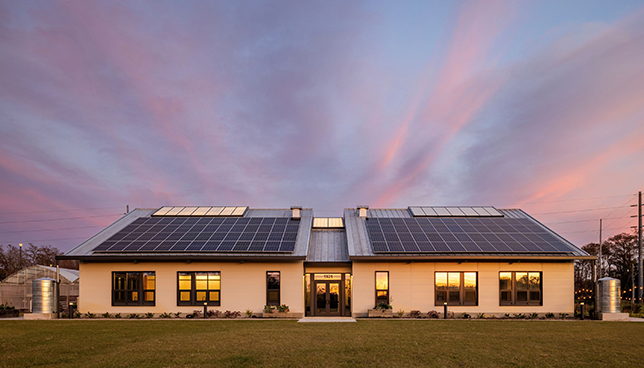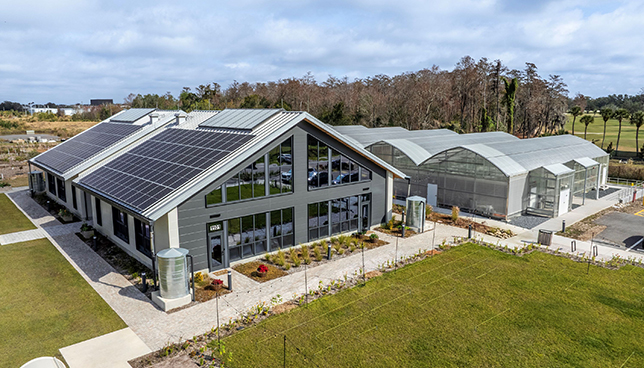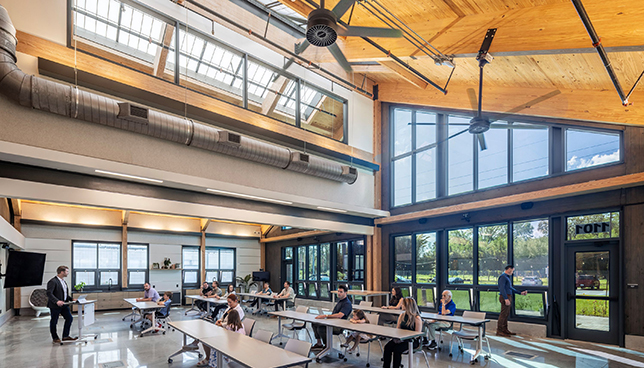Ancient Resilience: How Indigenous Intelligence Shapes the 4Roots Education Building
- By Philip Donovan
- 06/10/25
As climate change intensifies, educational spaces must evolve beyond basic sustainability toward true resilience – we must design environments that can adapt, respond, and thrive amid shifting, and intensifying, climate hazards. Drawing on indigenous wisdom and nature-based strategies, integrating resilient design offers a path to create learning environments that are not only functional but deeply in tune with their natural surroundings. Our place in a changing world can no longer sustain a one-size-fits-all approach to educational facilities; our learning environments must once again embrace the adaptive, indigenous intelligence that is foundation to true resilience for both people and place.
 Photos courtesy of Chad Baumer Photography
Photos courtesy of Chad Baumer Photography
Memory and Adaptation
Florida, historically vulnerable to hurricanes, flooding, and intense heat, provides powerful examples of environmentally adaptive design. Indigenous peoples slowly learned to create structures aligned with natural forces, such as the chickee hut – an open-air shelter made from locally harvested cypress logs and palmetto thatch. Elevated on stilts to withstand flooding, the chickee allowed wind to flow freely across and through the structure, reducing storm damage and naturally cooling occupants. Its materials were inherently resilient, mold and insect resistant, and quickly rebuildable after often-severe storms with rapidly renewable, local materials.
Evolutionary Necessities
Later, European settlers in Florida further evolved this knowledge through the construction of a specific vernacular architecture, the “cracker house”. Elevated on wooden piers for ventilation and flood protection, these structures incorporated passive cooling features, such as central breezeways and deep porches. Constructed from locally abundant pine and cypress, they also provided durable protection and pest resistance. The cracker house exemplifies how settlers adapted to their environment using building methods they learned from Florida’s native tribes.
As technology and industrialization have advanced, mass production and comfort have led us away from this intuitive design approach. Air conditioning and modern materials have replaced passive systems, creating sealed, energy-hungry buildings with prototypical layouts that ignore the natural rhythms of life that support better learning. Today, this unsustainable path increases our vulnerability to climate hazards, making resilience more critical than ever.

Back to Our Roots
The 4Roots Education Building in Orlando, Florida, set a new standard for climate resilience and sustainability by reclaiming and evolving these historical principles for modern educational spaces. Located in Orlando’s historic Packing District just three miles north of downtown, the 4Roots Regenerative Urban Farm Campus is a community-focused initiative that promotes sustainable agriculture, education, and resilient design. A former City dumping site, the 20-acre campus sits below the flood plain elevation along the headwaters of the environmentally sensitive Wekiva River Basin. For 50 years this site suffered from industrial dumping. Commercial run-off flowed into engineered canals that bypass the adjacent wetland and direct toxins into the natural water systems. Dedicated to revitalizing this underutilized urban infill site, 4Roots seeks to restore the distressed area while serving as a model for community and cultural regeneration, grounded in its mission of food security through regenerative farming education.
Designed to support this mission, the 4Roots Education Building is 7,700-square-foot mass timber, carbon-neutral classroom facility that physically and visually immerses students in the regenerative farm environment. The building, laid out in a simple dog-trot style plan, features four flexible classroom spaces accessed from a central corridor. With airlock vestibules on each end, this corridor helps to reduce energy loss and minimize indoor contaminants as visitors walk between the farm and the learning spaces. The building’s active and passive systems are integrated into the fabric of the space to support and enhance educational curriculums from kindergarten through college and beyond. Meanwhile, exposed structural and MEP systems reduce material footprints while educating occupants about the learning spaces’ simple, effective design.

Simple Strategies for Resiliency
The 4Roots Education Building’s design, construction, and operations integrate five key resilient strategies, all developed to reduce the long-term operational resource footprint and costs. These strategies also impart students and visitors with a deeper understanding of resilience attuned to the surrounding site and Central Florida’s shifting climate conditions.
- Elevation and Flood Protection: The 7,700-square-foot facility is built on a raised pad with an additional protective curb, ensuring flood resilience amid Florida’s intense storms. This design aligns directly with indigenous practices seen in the chickee and cracker houses.
- Passive Cooling and Energy Efficiency: Deep roof overhangs, operable high-performance windows, automated shading systems, and high-volume low-velocity fans provide natural ventilation to reduce energy use. Ninety-eight percent of the building’s regularly occupied spaces are naturally daylit with passively and actively shaded glazing systems and skylights in all educational spaces. These elements echo the strategies once prevalent in historic Florida architecture.
- Local, Low-Carbon Materials: The building employs regional materials, including a mass timber structural system of sustainably harvested pine with cypress millwork sourced directly from the site. The design further reduced embodied carbon by exposing these building systems, minimizing the amount of construction materials used overall. This design approach reduces the total carbon footprint while reinforcing ecological balance and local economic resilience.
- Water Integration and Management: The site incorporates permaculture principles with native plants and regenerative landscaping to naturally manage stormwater, mitigate flooding, and enhance biodiversity. Rainwater harvesting and condensate recovery reduce potable water use and transform water management into an integrated, regenerative system.
- Self-Sufficient Energy Production: The building’s roof is covered in a solar panel array that produces 160 percent of the energy required for the facility’s operations. The excess ensures energy stability, enhancing daily resilience and contributing surplus renewable energy to the community grid.
- Living Building Challenge Principles: The building’s design and construction followed key imperatives toward obtaining the Living Building Challenge’s Energy Petal. These imperatives significantly reduce waste, eliminate red-list chemicals, and prioritize sustainability and health in every material and practice used.
The 4Roots Education Building proves that resilience and regenerative design are not merely theoretical – they are practical, achievable strategies deeply rooted in indigenous wisdom. By integrating historical insights with modern technology, this project serves as a compelling, transformative blueprint for building sustainable, resilient, and thriving learning environments. Designed to remain functional and supportive, even in times of crisis, 4Roots embeds resilience into daily life rather than solely as a disaster response. This ethos extends beyond physical infrastructure into educational programming, promoting understanding of sustainable food production, ecological stewardship, and the interdependence between human and natural systems. The site’s educational mission empowers communities to actively participate in climate adaptation and resilience, fostering cultural shifts vital for long-term sustainability.
Financially, investing in resilient design demonstrates significant economic advantages. According to the National Institute of Building Sciences, every dollar spent on resilient construction saves between six and eleven dollars in future disaster recovery costs. Additionally, resilient buildings typically have lower operational costs, higher property values, reduced insurance premiums, and lower maintenance expenses. They return to operations faster after disaster strikes with minimal stress and damage to their built environment. The 4Roots Education Building has already weathered several hurricanes during construction and initial operations, most recently remaining high and dry, fully functional during Hurricane Milton in October 2024.
Ultimately, resilience is proactive rather than reactive. It requires us to rethink our built environments and align them with the dynamic rhythms of our ecosystem. By investing in adaptive, regenerative educational spaces like 4Roots, we can better survive climate shocks and live in balance with nature while preparing our communities to thrive amidst climate uncertainties for generations to come.